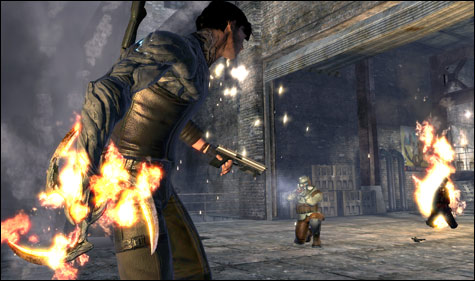
GREAT GIMMICK: Using the glaive is such a blast that you’ll be tempted to ignore Dark Sector’s numerous problems. |
| Dark Sector | For Xbox 360 and Playstation 3 | Rated M for Mature | Developed by Digital Extremes | Published by D3 Publisher |
We’ve all known someone whose IQ score was off the charts, whose casual mastery of esoteric subjects inspired awe in his acquaintances, and who at the end of the day was unable to untie his own shoes. Dark Sector is the video-game equivalent of that guy. It’s absolutely brilliant at the things it does well, but when it comes to the everyday stuff that puts a game on a solid foundation, it can’t get out of its own way. You want to grab it by the shoulders and scream: “Do you realize how many other games would kill to have a gimmick as cool as yours?”That gimmick is the glaive: a triple-bladed, boomerang-like weapon that acquires more and more superpowers as you progress. (Dictionary.com says a glaive is just a boring old broadsword, but Dark Sector doesn’t have time for book learnin’.) Although the game appears to be yet another in a long line of duck-and-cover shooters, this versatile weapon keeps it from feeling like an imitator. The glaive’s basic function is a simple throw: whip it at an enemy and it will automatically return to you.
But the twists keep coming. If you release the glaive at just the right moment, it will do quadruple damage — good for the lovingly rendered dismemberment of your foes. If you toss the blade through flame or electricity, it will temporarily take on that element’s power. The glaive can manifest an energy shield, or be used to retrieve distant items. The best feature is Aftertouch, which allows you to take control of the airborne glaive in slow motion. This requires a skill set different from what you need for real-time aiming; it also affords a more satisfying reward when, say, you bank the glaive around a corner to decapitate a concealed mutant. Although your character can wield an array of different firearms, there’s rarely a compelling reason to do so.
Using the glaive is such a blast that you’ll be tempted to ignore Dark Sector’s numerous problems, but after a few hours of play the little annoyances start to feel like death by paper cut. The monochromatic environments are gorgeously drawn, but aside from a few breakable ammo crates, they’re barely interactive. Your character runs into invisible barriers at the edges of the maps — that’s just poor level design. Some of the glaive’s powers can be used only in prescribed instances. This is irritating: why can’t you break a lightbulb, say, to electrify your weapon?
Other flaws are fatal. Melee combat is poorly implemented, with inept collision detection and a frustrating lack of frame cancelling. (But give it points for the cinematic “finishers,” which are so brutal that Dark Sector has yet to be approved for release in Australia.) Worst of all are the frequent episodes in which the designers all but admit that they’re out of ideas and start throwing waves of enemies at you. For gameplay that relies so much on sticking and moving, this artificial lengthening of some levels can kill the pacing.
The strength of the glaive mechanics may make Dark Sector worth a rental. Few games have a hook as inspired or as well-implemented as this one. But few games make as many rookie mistakes, either. Publishers release hundreds of mediocre, forgettable games every year. It’s a shame that Dark Sector should be among them.